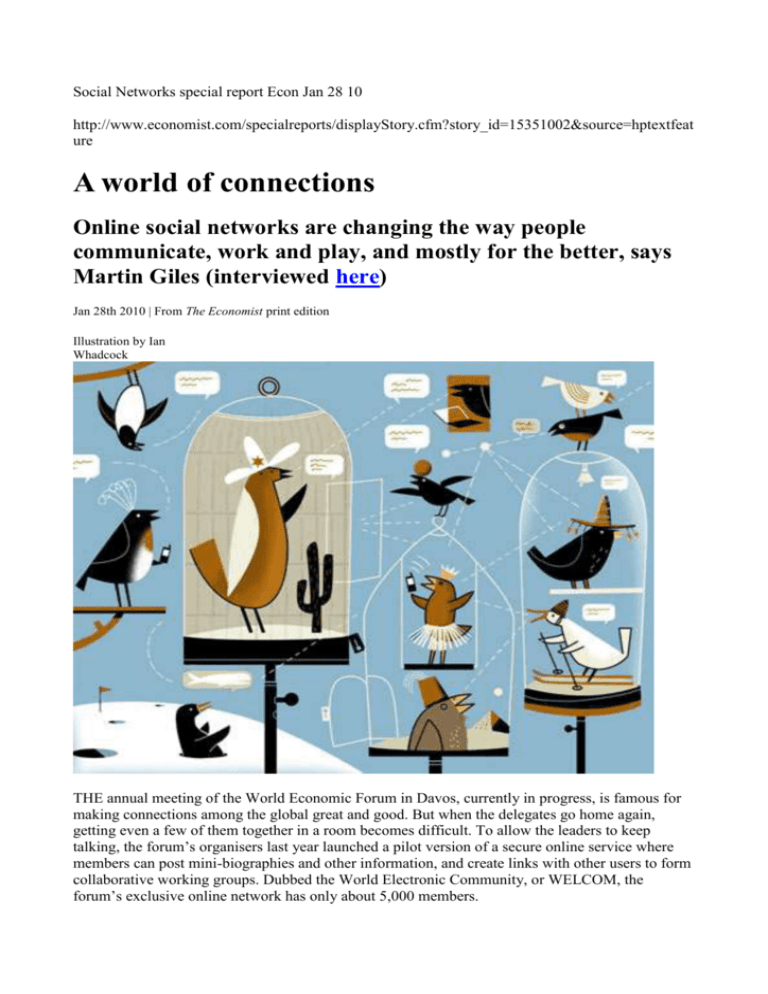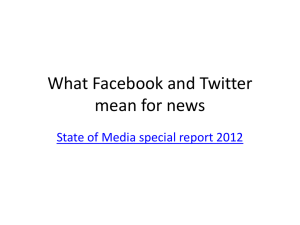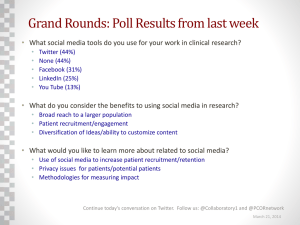
Social Networks special report Econ Jan 28 10
http://www.economist.com/specialreports/displayStory.cfm?story_id=15351002&source=hptextfeat
ure
A world of connections
Online social networks are changing the way people
communicate, work and play, and mostly for the better, says
Martin Giles (interviewed here)
Jan 28th 2010 | From The Economist print edition
Illustration by Ian
Whadcock
THE annual meeting of the World Economic Forum in Davos, currently in progress, is famous for
making connections among the global great and good. But when the delegates go home again,
getting even a few of them together in a room becomes difficult. To allow the leaders to keep
talking, the forum’s organisers last year launched a pilot version of a secure online service where
members can post mini-biographies and other information, and create links with other users to form
collaborative working groups. Dubbed the World Electronic Community, or WELCOM, the
forum’s exclusive online network has only about 5,000 members.
But if any service deserves such a grand title it is surely Facebook, which celebrates its sixth
birthday next month and is now the second most popular site on the internet after Google. The
globe’s largest online social network boasts over 350m users—which, were it a nation, would make
Facebook the world’s third most populous after China and India. That is not the only striking
statistic associated with the business. Its users now post over 55m updates a day on the site and
share more than 3.5 billion pieces of content with one another every week. As it has grown like
Topsy, the site has also expanded way beyond its American roots: today some 70% of its audience
is outside the United States.
Although Facebook is the world’s biggest social network, there are a number of other globetrotting
sites, such as MySpace, which concentrates on music and entertainment; LinkedIn, which targets
career-minded professionals; and Twitter, a networking service that lets members send out short,
140-character messages called “tweets”. All of these appear in a ranking of the world’s most
popular networks by total monthly web visits (see chart 1), which also includes Orkut, a Googleowned service that is heavily used in India and Brazil, and QQ, which is big in China. On top of
these there are other big national community sites such as Skyrock in France, VKontakte in Russia,
and Cyworld in South Korea, as well as numerous smaller social networks that appeal to specific
interests such as Muxlim, aimed at the world’s Muslims, and ResearchGATE, which connects
scientists and researchers.
Going public
All this shows just how far online communities have come. Until the mid-1990s they were largely
ghettos for geeks who hid behind online aliases. Thanks to easy-to-use interfaces and fine-grained
privacy controls, social networks have been transformed into vast public spaces where millions of
people now feel comfortable using their real identities online. ComScore, a market-research firm,
reckons that last October big social-networking sites received over 800m visitors. “The social
networks’ greatest achievement has been to bring humanity into a place that was once cold and
technological,” says Charlene Li of the Altimeter Group, a consulting firm.
Their other great achievement has been to turn themselves into superb tools for mass
communication. Simply by updating a personal page on Facebook or sending out a tweet, users can
let their network of friends—and sometimes the world—know what is happening in their lives.
Moreover, they can send out videos, pictures and lots of other content with just a few clicks of a
mouse. “This represents a dramatic and permanent upgrade in people’s ability to communicate with
one another,” says Marc Andreessen, a Silicon Valley veteran who has invested in Facebook,
Twitter and Ning, an American firm that hosts almost 2m social networks for clients.
campaign strategy that helped sweep Barack Obama to victory in the presidential race. And
people are making
copious use of that ability. Nielsen, a market-research firm, reckons that since February 2009 they
have been spending more time on social-networking sites than on e-mail, and the lead is getting
bigger. Measured by hours spent on them per social-network user, the most avid online networkers
are in Australia, followed by those in Britain and Italy (see chart 2). Last October Americans spent
just under six hours surfing social networks, almost three times as much as in the same month in
2007. And it isn’t just youngsters who are friending and poking one another—Facebook-speak for
making connections and saying hi to your pals. People of all ages are joining the networks in ever
greater numbers.
Social-networking sites’ impressive growth has attracted much attention because the sites have
made people’s personal relationships more visible and quantifiable than ever before. They have also
become important vehicles for news and channels of influence. Twitter regularly scores headlines
with its real-time updates on events like the Mumbai terrorist attacks and on the activities of its
high-profile users, who include rap stars, writers and royalty. And both Twitter and Facebook
played a starring role in the online
Delivery time
But like Mr Obama, social networks have also generated great expectations along the way on which
they must now deliver. They need to prove to the world that they are here to stay. They must
demonstrate that they are capable of generating the returns that justify the lofty valuations investors
have given them. And they need to do all this while also reassuring users that their privacy will not
be violated in the pursuit of profit.
Illustration by Ian Whadcock
In the business world there has also been much hype around something called “Enterprise 2.0”, a
term coined to describe efforts to bring technologies such as social networks and blogs into the
workplace. Fans claim that new social-networking offerings now being developed for the corporate
world will create huge benefits for businesses. Among those being touted are services such as
Yammer, which produces a corporate version of Twitter, and Chatter, a social-networking service
that has been developed by Salesforce.com.
To sceptics all this talk of twittering, yammering and chattering smacks of another internet bubble
in the making. They argue that even a huge social network such as Facebook will struggle to make
money because fickle networkers will not stay in one place for long, pointing to the example of
MySpace, which was once all the rage but has now become a shadow of its former self. Last year
the site, which is owned by News Corp, installed a new boss and fired 45% of its staff as part of a
plan to revive its fortunes. Critics also say that the networks’ advertising-driven business model is
flawed.
Within companies there is plenty of doubt about the benefits of online social networking in the
office. A survey of 1,400 chief information officers conducted last year by Robert Half Technology,
a recruitment firm, found that only one-tenth of them gave employees full access to such networks
during the day, and that many were blocking Facebook and Twitter altogether. The executives’
biggest concern was that social networking would lead to social notworking, with employees using
the sites to chat with friends instead of doing their jobs. Some bosses also fretted that the sites
would be used to leak sensitive corporate information.
This special report will examine these issues in detail. It will argue that social networks are more
robust than their critics think, though not every site will prosper, and that social-networking
technologies are creating considerable benefits for the businesses that embrace them, whatever their
size. Lastly, it will contend that this is just the beginning of an exciting new era of global
interconnectedness that will spread ideas and innovations around the world faster than ever before.
Social networking use Econ Jan 29 10
http://www.economist.com/daily/news/displaystory.cfm?story_id=15408371&fsrc=nwl
Twittering classes
Jan 29th 2010
From Economist.com
Where users spend most time on social-network sites
SOCIAL networks are now a ubiquitous part of daily life in western countries. Facebook, for
example, which was launched in 2004, now boasts over 350m users, more than two-thirds of them
outside of America. The keenest social-network users, Australians, spent over seven hours a month
on such sites, “poking” friends and “twittering” in late 2009, twice as much as users in Japan. Yet
making big revenues and profits from such habits remain Facebook’s greatest challenges.
QuickTime™ e un
decompressore
sono necessari per visualizzare quest'immagine.
Copyright © 2010 The Economist Newspaper and The Economist Group. All rights reserved.





